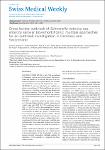Cross-border outbreak of Salmonella enterica ssp. enterica serovar Bovismorbificans: multiple approaches for an outbreak investigation in Germany and Switzerland
Knoblauch, Astrid M.
Bratschi, Martin W.
Zuske, Meike K.
Althaus, Denise
Stephan, Roger
Hächler, Herbert
Baumgartner, Andreas
Prager, Rita
Rabsch, Wolfgang
Altpeter, Ekkehardt
Jost, Marianne
Mäusezahl, Mirjam
Hatz, Christoph
Kiefer, Sabine
QUESTION UNDER STUDY: In July 2014, an outbreak of Salmonella enterica ssp. enterica serovar Bovismorbificans was detected in Switzerland. The goal of the outbreak investigation was to rapidly identify and eliminate the contamination source in order to prevent new cases. METHODS: A case-case study design was applied comprising reported cases of S. Bovismorbificans and cases of other serovars. A trawling questionnaire was administered by telephone interview. Data were collected for 34 cases (20 S. Bovismorbificans and 14 Salmonella spp.) pertaining to food consumption during the 72 hours prior to symptom onset. RESULTS: A statistically significant association between an S. Bovismorbificans infection and the consumption of ‘salads’ (odds ratio [OR] 14.3, 95% confidence interval [CI] 1.47–138.27) as well as the consumption of ‘sprouts’ (OR 10.6, 95% CI 1.16–97.59) was found. Principal places of consumption of ‘salads’ and ‘sprouts’ in outbreak cases were restaurants in southern Germany (80.0%, 95% CI 56.3%–94.3%). Microbiological analysis in Germany identified S. Bovismorbificans on sprouts, and genotype analysis confirmed that Swiss and German cases shared the same outbreak strain. The contaminated products were removed from the market in Germany, preventing an on-going outbreak. CONCLUSION: The combination of the applied methods and the collaboration between the two countries proved to be crucial elements of this investigation. A series of sprouts-associated salmonellosis outbreaks underpin the importance of this vegetable as a potential food-borne pathogen carrier.
No license information

